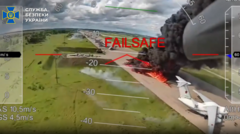On June 1, Ukraine executed an unprecedented drone attack dubbed "Spider Web," targeting several Russian airbases and nuclear-capable bombers. The operation, meticulously planned over 18 months, involved smuggling over 100 drones into Russia and resulted in significant damage to military assets, indicating a notable shift in the conflict's dynamics.
Ukraine's 'Spider Web' Drone Assault: A Game-Changer for the Conflict

Ukraine's 'Spider Web' Drone Assault: A Game-Changer for the Conflict
In a groundbreaking operation, Ukraine carries out a strategic drone attack against Russian bombers, showcasing advanced tactics and significant military ingenuity.
On June 1, Ukraine orchestrated an exceptionally bold drone strike, named "Spider Web," targeting several strategic Russian airbases housing nuclear-capable bombers. This operation, which had been under development for 18 months, demonstrated Ukraine's escalating military capabilities and marked a significant escalation in the ongoing conflict.
The assault involved over 100 Ukrainian drones, which struck five different regions within Russia, from Murmansk in the Arctic to Amur in the east—covering a vast geographic span of over 8,000 km. While the Russian Defense Ministry acknowledged the attacks, it claimed damage was limited to bases in Murmansk and Irkutsk, asserting that many attacks were repelled.
Photos released shortly after the attack showed Vasyl Maliuk, the head of Ukraine's Security Service (SBU), analyzing satellite maps that clearly indicated the targeted airfields. The drones were ingeniously smuggled into Russia, hidden within wooden cabins on lorries, and launched from these concealed locations, with drivers reportedly unaware of their true cargo. One driver recounted how he and others attempted to fend off the drones with stones when they spotted them emerging from the vehicle.
In a victory declaration, President Volodymyr Zelensky highlighted the meticulous planning that went into the operation, claiming that 117 drones were successfully deployed to strike designated targets, including locations in proximity to the Russian security services' facilities. He confirmed that those who aided in facilitating the attack had been safely extracted from Russia.
Images released by the SBU indicated that Ukrainian forces employed simple but effective quadcopter drones capable of carrying substantial payloads. According to drone experts, the success of this operation was contingent on an intricate network enabling the remote control of the drones, likely utilizing satellite or internet links to overcome potential Russian defenses.
Despite the absence of official Russian confirmations regarding the extent of aircraft losses, Zelensky stated that 41 bombers had been damaged in the attacks, with at least 13 reported destroyed. Video evidence corroborates the infliction of damage on key military aircraft, including the Tu-95 and Tu-160 bombers, known for their capabilities to launch extensive missile strikes.
The implications of this operation are significant, as the repaired bombers will be difficult to restore, and replacements are virtually impossible due to the halted production lines. The Ukrainian drone incursion serves as a potent reminder of the shifting military tactics in the conflict, with analysts suggesting that the operation cost Russia approximately $7 billion in damages.
Russian state media appeared to downplay the incident, refraining from significant coverage or commentary, while Ukrainian civilians expressed their excitement and pride over the successful operation on various platforms, labeling it a historic feat. As tensions escalate, Ukraine's precise and demanding tactics signal a formidable shift in the dynamics of the ongoing conflict, setting a precedent for future engagements.






















